December 2025
The global lubricants market size accounted for USD 150.56 billion in 2025 and is forecasted to hit around USD 211.53 billion by 2034, representing a CAGR of 3.85% from 2025 to 2034. The rapid industrial growth, growing demand from the automotive sector, and advancements in lubricant technology drive the market growth.
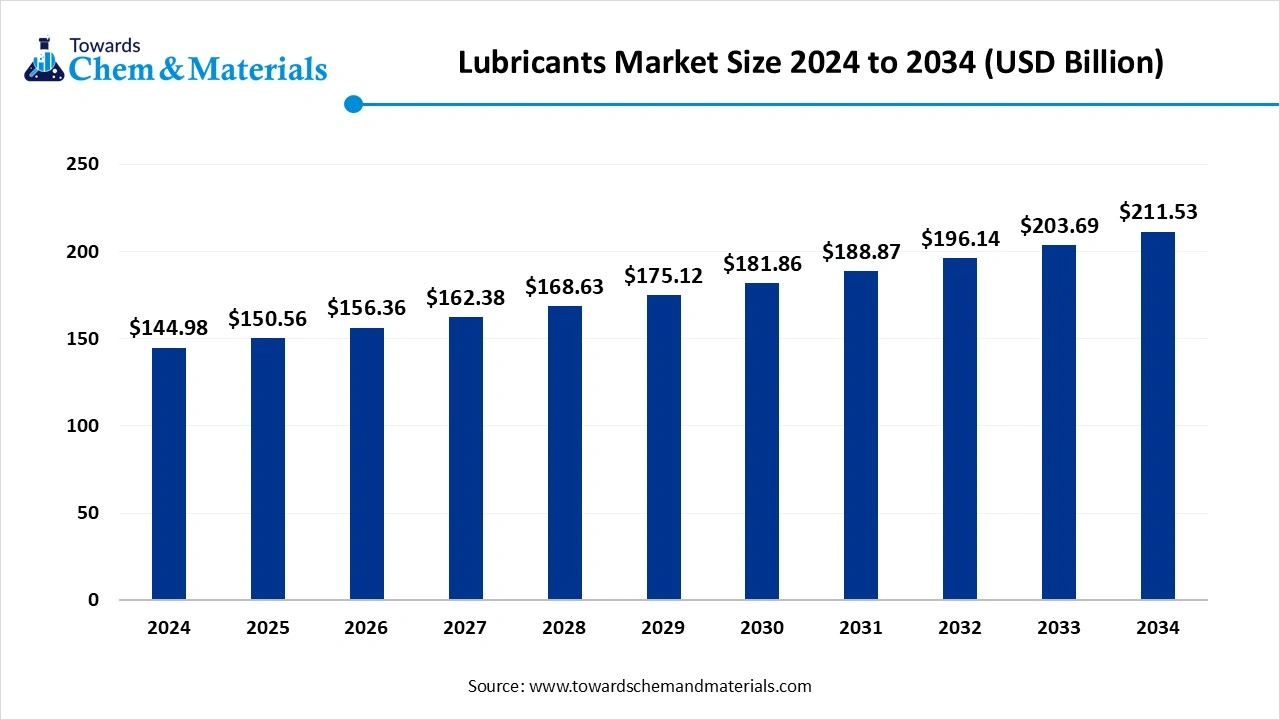
Lubricants are substances which is used to minimize heat generation, friction between moving parts, and wear. They are available in diverse forms like solids, liquids, and even gases. They help in preventing corrosion, heat transfer, and sealing. Lubricants consist of high-boiling-point, high-viscosity-index, and low-freezing-point. It consists of thermal stability, hydraulic stability, and high oxidation resistance. Lubricants are made up of 10% additives and 90% base oils. Liquid lubricants include mineral oils, synthetic oils, and vegetable oils. Solid lubricants include molybdenum disulfide, polytetrafluoroethylene, graphite, and boron nitride.
The growing manufacturing facilities globally increase demand for industrial lubricants. The increasing adoption of automation in various sectors increases the consumption of various lubricants. The rising vehicle ownerships and growing vehicle sales increases demand for automotive lubricants to ensure smooth operation. The growing demand for commercial vehicles and passenger vehicles helps in the market growth. Factors like a rise in electric vehicles, growing demand for high-performance engines, advancements in lubricant formulations, and growing demand from the marine & aerospace industry drive the overall growth of the lubricants market.
The Growing Construction Industry Propels Lubricants Market Growth
The rapid urbanization increases demand for various construction activities like residential, commercial, and infrastructural construction. The growing various construction activities is driving demand for a wide range of machinery. The growing demand for various equipment like bulldozers, haul trucks, drilling rigs, excavators, cranes, concrete mixers, and loaders increases the demand for lubricants for various applications like hydraulics, engines, and transmission. The growing demand for extending longevity and maintaining the performance of equipment increases demand for lubricants.
The growing investments in infrastructure development, like buildings, bridges, and roads, fuel demand for high-performance construction equipment that uses lubricants. The growing adoption of robotics & automation in construction projects is leading to demand for specialized lubricants. The strong focus of the construction industry on sustainability increases the adoption of eco-friendly lubricants. The growing construction industry is a key driver for the growth of the lubricants market.
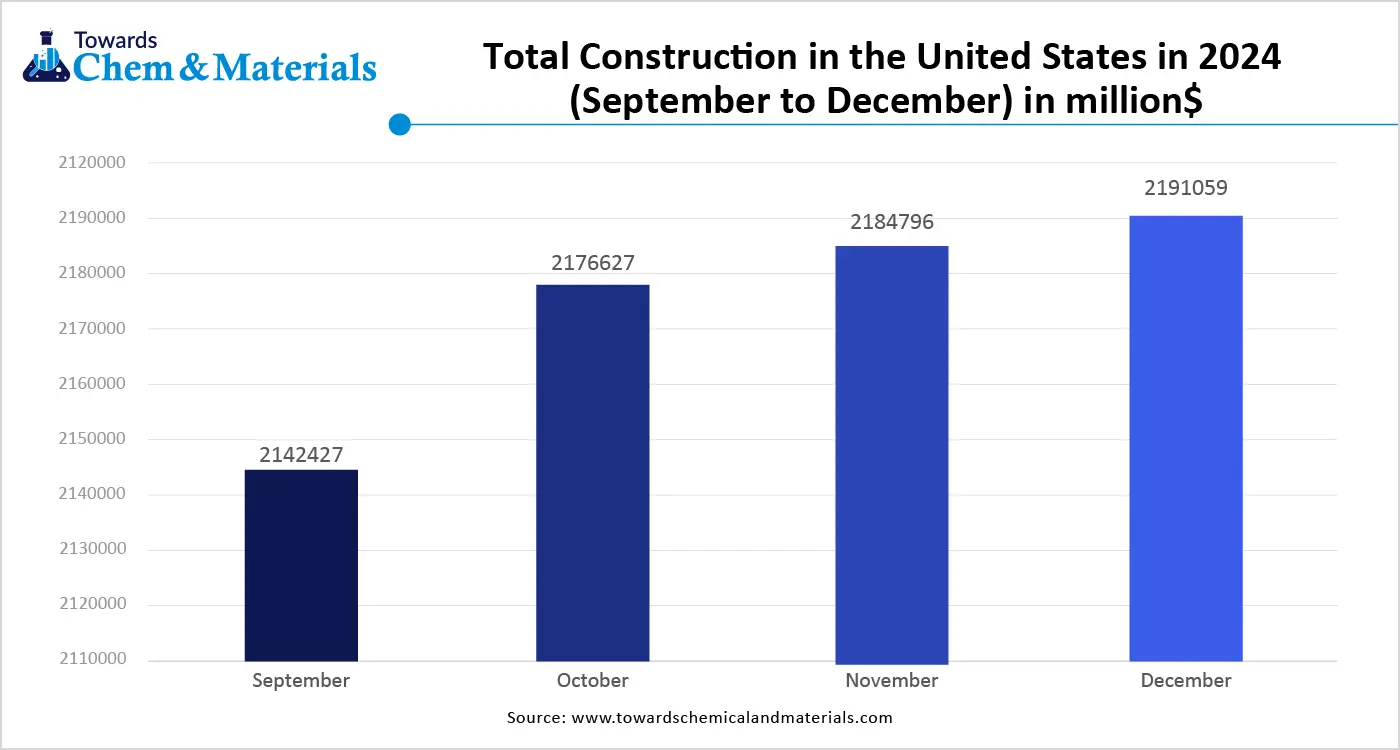
| Report Attributes | Details |
| Market Size in 2025 | USD 150.56 Billion |
| Expected Size by 2034 | USD 211.53 Billion |
| Growth Rate from 2025 to 2034 | CAGR 3.85% |
| Base Year of Estimation | 2024 |
| Forecast Period | 2025 - 2034 |
| Dominant Region | Asia Pacific |
| Segment Covered | By Product, By Application, By Region |
| Key Companies Profiled | CASTROL LIMITED, FUCHS, ExxonMobil Corporation, TotalEnergies, AMSOIL INC., Chevron Overseas Limited, Eurol, Caltex Lubricants, Shell, ENGEN PETROLEUM LTD, Puma Energy, HP Lubricants, Petronas, Motul, Lukoil |
Expansion of the Transportation Sector Surge Demand for Lubricants
The growing expansion of the transportation sector increases demand for lubricants for smooth operation. The growing population and rising demand for various transportation facilities like railway transport, passenger cars, and commercial vehicles increase the demand for lubricants. The growing need for public transportation systems like trains, buses, metros, and ferries fuels demand for lubricants to ensure patient safety and maintain smooth operations.
The growing transportation-related industries like aviation and marine shipping increase demand for lubricants. The growing demand for commercial vehicles like heavy-duty vehicles, buses, and taxis fuels demand for lubricants, including heavy-duty engine oils. The growing preference for marine transportation and air travel increases demand for lubricants with superior properties. The growing transportation industry utilizes various lubricants like transmission fluids, specialized fluids, engine oils, and greases. The growing expansion of the transportation sector creates an opportunity for the growth of the lubricants market.
Raw Material Price Fluctuations Limit the Expansion of the Lubricants Market
Despite several benefits of the lubricants in various sectors, the fluctuations in raw material prices restrict the growth of the market. Factors like crude oil price fluctuations, supply chain disruptions, base oil availability, and regulatory changes are responsible for fluctuating raw material prices. The mineral oil-based lubricants are derived from crude oil. The fluctuations in crude oil prices due to global demand & supply restrict market expansion. Factors like weather events, refinery capacity, and maintenance costs directly affect the availability of base oils. The various geopolitical events, like trade tensions, political instability, and conflicts, increase the cost of raw materials. Fluctuating raw material prices hamper the growth of the market.
Which Region Dominated the Lubricants Market in 2024?
The Asia Pacific hair lubricants market is expected to increase from USD 69.03 billion in 2025 to USD 97.09 billion by 2034, growing at a CAGR of 3.86% throughout the forecast period from 2025 to 2034. Asia Pacific dominated the market in 2024. The rapid industrialization in the region, including mining, manufacturing, and construction, increases demand for lubricants. The growing production of vehicles and the rising expansion of the automotive industry help in the market growth. The growing investment in infrastructure development increases demand for lubricants. The growing consumer spending on goods & services like vehicles, fuel adoption of lubricants. The booming construction sector in the region increases demand for lubricants. Additionally, growing vehicle ownership and rapid industrial growth in countries like India & China drive the overall growth of the market.

China Lubricants Market Trends
China is a major contributor to the market. The growing sales and production of vehicles increase demand for various lubricants like transmission fluids, greases, engine oils, and many others. The growing expansion of a manufacturing base, like equipment manufacturing and machinery, helps in the market growth. The strong government support for the construction and automotive industry increases demand for lubricants. The growing production of electric vehicles is fueling demand for lubricants. The growing mining sector, especially for gold, coal, and iron ore, leads to a need for heavy machinery, driving overall growth of the market.
Why Lubricants Market Growing in India?
India is significantly growing in the lubricants market. The growing sales of two-wheelers and passenger vehicles increase the demand for lubricants like engine oils. The rising disposable incomes and growing spending on personal vehicles help in the market growth. The growing expansion of various industries like construction, manufacturing, and mining leads to higher demand for lubricants. The growing development of infrastructure projects increases demand for heavy machinery is fueling demand for lubricants. The growing focus on maintaining vehicles and purchasing more vehicles increases the consumption of lubricants. The growing adoption of electric vehicles supports the overall growth of the market.
How is North America the Fastest Growing in the Lubricants Market?
North America experiences the fastest growth in the market during the forecast period. The growing expansion of various sectors like mining, manufacturing, and construction in the region increases demand for various lubricants like turbine oils, metalworking fluids, and hydraulic oils. The growing demand for commercial & passenger vehicles and the increasing production of vehicles help in the market growth.
The stringent environmental regulations fuel the adoption of synthetic & bio-based lubricants. The ongoing technological advancements in lubricant formulations help the market growth. The growing aerospace industry, like aircraft maintenance & manufacturing, increases demand for lubricants for various components like landing gear, engines, and hydraulics. The growing production in various sectors like energy, automotive, and manufacturing drives the overall growth of the market.
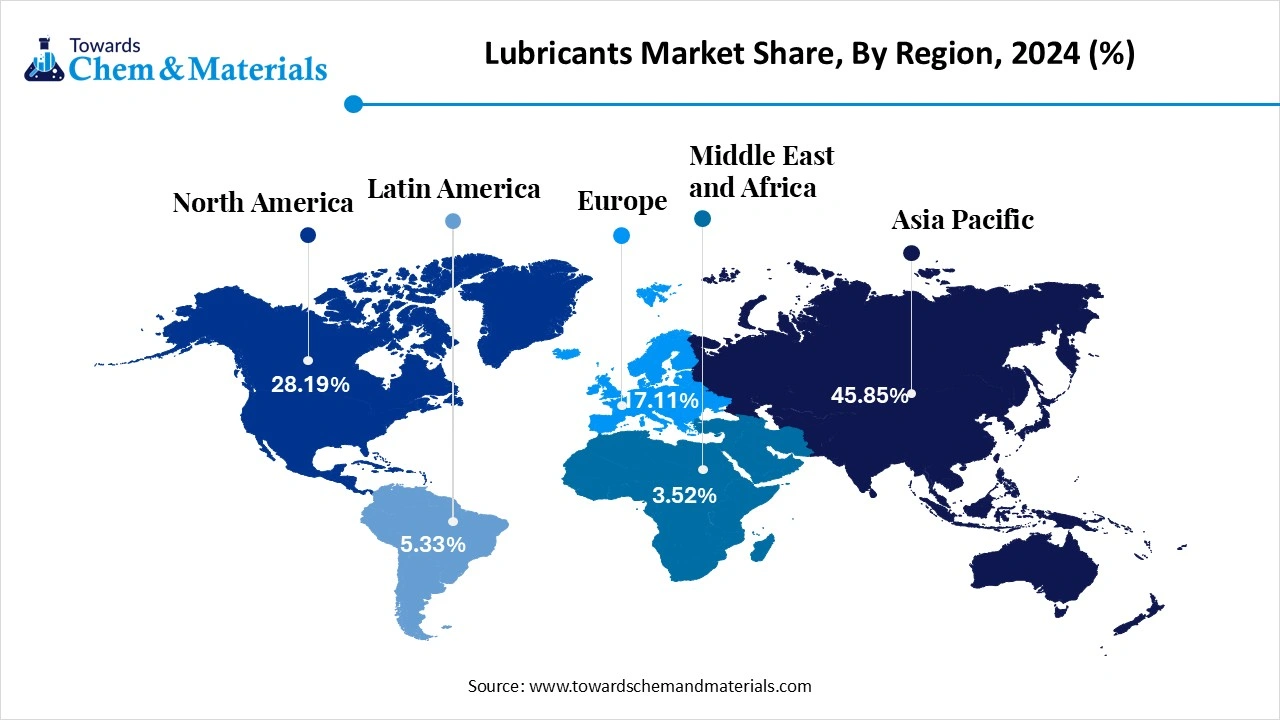
United States Lubricants Market Trends
The United States is a key contributor to the market. The presence of diverse industrial sectors like energy, manufacturing, and construction increases demand for lubricants. The aging vehicle fleet and the rise of electric vehicles help in the market growth. The growing innovations in the lubricants sector and stringent environmental regulations increase the production of bio-based & synthetic lubricants. The well-established logistics & transportation infrastructure fuels demand for lubricants. The well-developed marine and aerospace industries contribute to the overall growth of the market.
How Mineral Oil Segment Dominated the Lubricants Market?
The mineral oil segment led the market in 2024. The growing demand from various industrial processes like mining, metalworking, and power generation helps in the market growth. Mineral oils are inexpensive and easily available across various industries. The growing automotive industry increases demand for mineral oil to maintain vehicle components' lifespan, engine performance, and fuel efficiency. The growing expansion of the automotive sector and rapid industrialization fuel demand for mineral oil. The growing demand from various sectors like industrial machinery, the marine sector, automotive, and agriculture drives the overall growth of the market.
The synthetic oil segment is the fastest growing in the market during the forecast period. The growing production of high-performance vehicles increases demand for synthetic oil. The growing demand for various industrial machinery, like manufacturing, mining, and construction, helps in the market growth. Synthetic oils provide better thermal breakdown & oxidation resistance and consist uniform molecular structure. They offer stable viscosity and reduce friction between engine components. Synthetic oils minimize volatility and reduce environmental impact. The growing demand from the defense and aerospace sector supports the overall growth of the market.
Why did the Automotive Segment Dominate the Lubricants Market?
The automotive segment dominated the lubricants market in 2024. The growing number of vehicles, like commercial vehicles and passenger cars, increases demand for lubricants. The increasing demand for repairing and maintaining vehicles helps in the market growth. The growing adoption of fuel-efficient vehicles increases demand for lubricants. The growing advancements in engine technology in modern vehicles fuel demand for high-performance lubricants. The growing vehicle ownership helps in the market growth. The growing automotive industry in countries like Brazil, China, & India, and the growing production of a wide range of vehicles, drives the overall growth of the market.
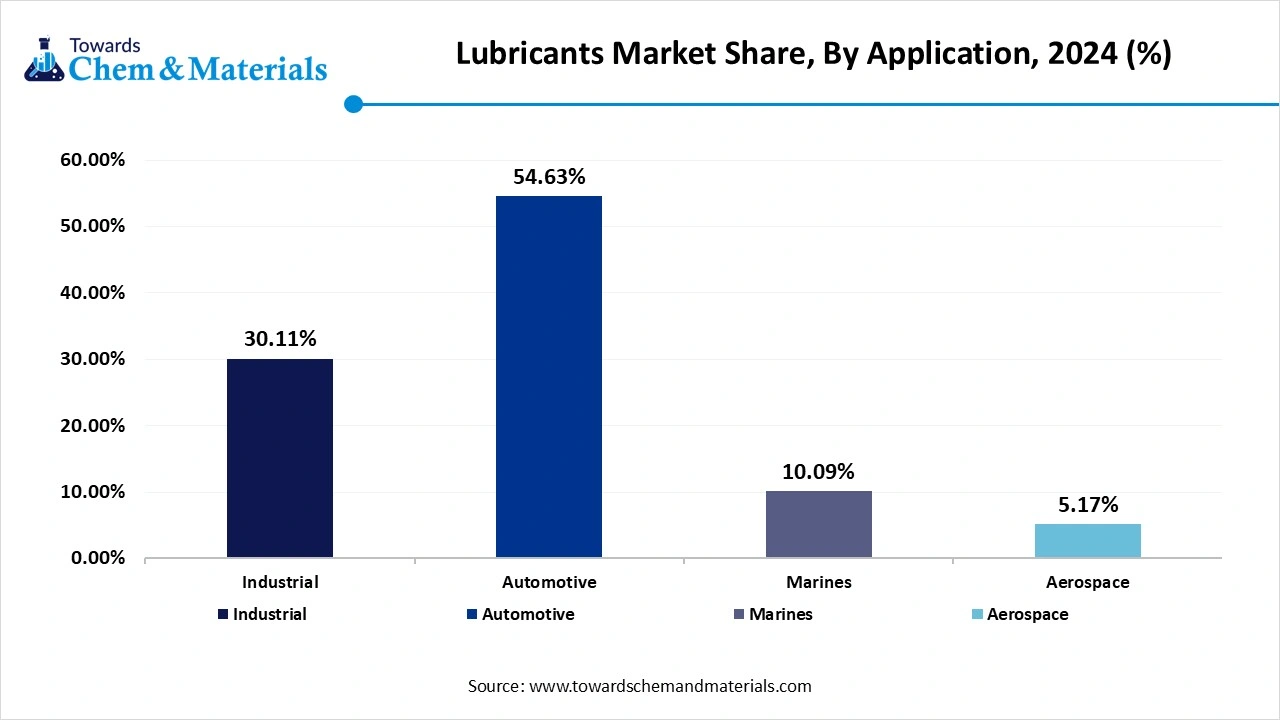
The industrial segment experiences the fastest growth in the market during the forecast period. The growing industrialization in various sectors like mining, manufacturing processes, and construction increases demand for industrial lubricants. These lubricants prevent corrosion, friction, and wear in machinery. Industrial lubricants extend equipment lifespan and preferred choice for various applications. These lubricants minimize maintenance costs and ensure smooth operation. The growing agriculture, power generation, and construction sectors increase demand for industrial lubricants. The increasing demand across various applications like compressor lubrication, metalworking, gear lubrication, and hydraulic systems supports the overall growth of the market.
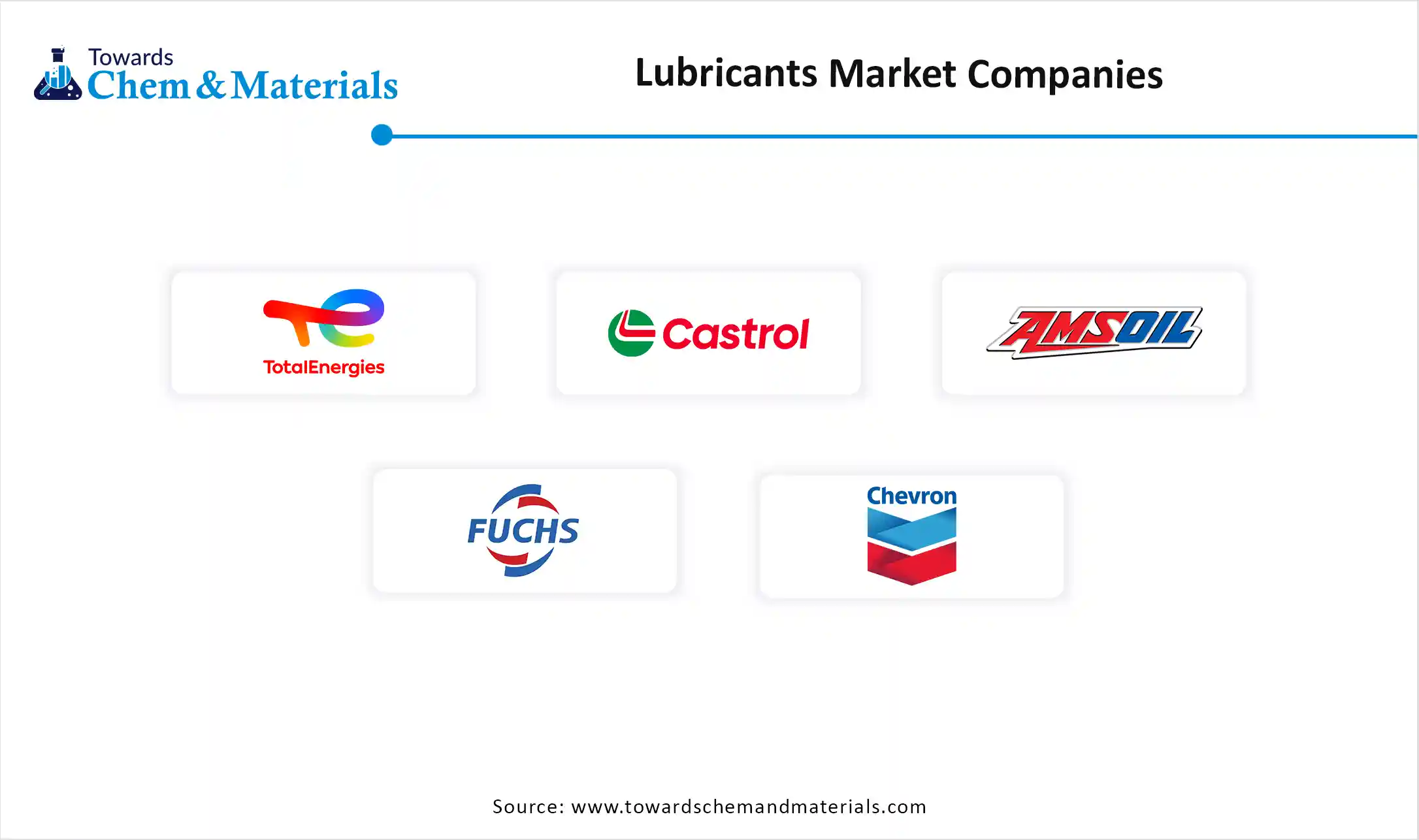
By Product
By Application
By Region
December 2025
December 2025
December 2025
December 2025